|
|
|
|
Integral
calculus
|
|
|
|
The
indefinite
integral
|
|
Differentiation of an indefinite integral with respect to upper
and lower limits
|
|
Let's
prove that the differentiation of an indefinite integral with respect to
the variable upper limit yields the function
that
is integrated, the integrand. |
| Let
write the increment DF
of the difference quotient DF/Dx |
 |
| As f
(x)
is continuous function in the closed interval [x,
Dx]
it takes its maximal value M
and minimal value m
at some points, x1
and x2,
as is shown in the right
figure. |
| Therefore,
according to the mean value theorem |
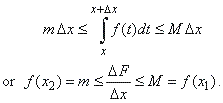 |
|
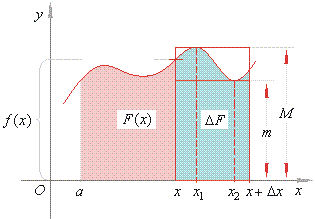 |
|
| Now,
as Dx
®
0
then x
+ Dx
tends to x,
and since f
is continuous then f(x1)
and f(x2)
approach f (x). |
 |
|
that is, by differentiating the indefinite integral of a
continuous function with respect to
the upper limit x
we get the
function that
is integrated (the integrand). Hence, we also can write |
 |
| that
is, by integrating the derivative F' (x),
or the differential dF,
we get the antiderivative F
(x). |
|
Therefore,
differentiation and integration are inverse-related operations, when
successively performed on the same
continuous function, the function stays unchanged. So, by integrating a
continuous function f
we get a new
function which, when differentiated, leads back to the original function
f. |
|
This property we use to check the result of integration thus, by differentiating the result of integration we must obtain the integrand
(the function that is integrated). |
| Similarly,
differentiation of the indefinite integral with respect to
the lower limit we write as |
|
 |
so
that, F' (x)dx
= -
f (x). |
|
|
Therefore,
the indefinite integral of a continuous function f
(x)
is any of its antiderivatives or primitive functions (whose derivative is
f (x)). |
|
|
The fundamental theorem of calculus
|
| The
theorem that states the relationship between integration and
differentiation, that is, between areas and tangent
lines, is called the fundamental theorem
of calculus |
|
|
The fundamental theorem of differential calculus
|
| If
f (x) is continuous on
closed interval [a,
b] and F
(x)
is defined to be |
 |
| then,
F
is differentiable on (a,
b)
such that F' (x)
= f (x) for all x
in (a,
b).
This means that |
 |
|
|
Evaluating definite integrals
using indefinite integrals
|
| To
evaluate the definite integral |
 |
we should find one primitive
function F (x)
or antiderivative |
|
|
of the function f (x),
and since the indefinite integral |
 |
is a primitive
function of f (x)
then, |
|
| as
two primitives of the same function can differ only by a
constant, we can write |
 |
| To
find the value of the constant C
that belongs to the lower limit a,
substitute x = a
to both sides of the |
| above equality, and
since |
 |
then
C
= -
F(a),
so that |
|
 |
| Therefore,
the
definite and indefinite integrals are related by the fundamental theorem
of calculus. |
| This
result shows that integration is inverse of differentiation. |
|
|
The fundamental theorem of integral calculus
|
| If
f
(x)
is integrable on the interval [a,
b]
and F (x)
is an antiderivative of f
on (a,
b),
then |
 |
| The
right side of the above equation we usually write |
 |
|
|
so
that, |
 |
|
| Thus,
to evaluate the definite integral we need to find an atiderivative F
of f,
then evaluate F (x)
at x = b
and at x
= a, and calculate the
difference F (b)
-
F (a). |
|
|
Evaluating
the definite integral examples
|
| Example:
Find
the area under the line f
(x)
= x
+ 1
over the interval [1,
5]. |
| Solution: To evaluate the
definite integral we need to find the atiderivative
F
of f (x)
= x
+ 1, evaluate |
| F
(x) at x
= 5
and at x
= 1,
and calculate the difference F
(5)
-
F (1). |
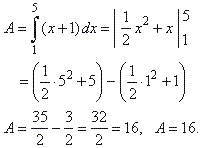 |
|
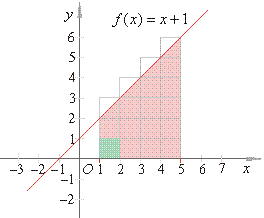 |
|
|
|
Cavalieri
- Gregory formula for quadrature of the parabola
|
| Example:
Let define the
surface area enclosed by the arc of the parabola f (x)
= Ax2
+ Bx
+ C
and x-axis
over the interval [a,
b]. |
| Solution: |
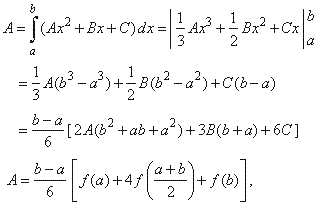 |
| where
the expression in the square brackets |
|
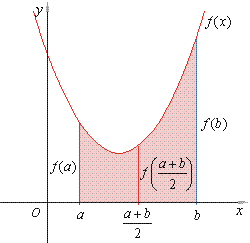 |
|
 |
| Thus,
the quadrature of the quadratic function leads to calculation of the
three ordinates or values of the function,
f (a),
f ((a+ b)/2)
and f
(b). |
|
|
|
|
|
|
|
|
|
|
|
|
|
|
|
|
|
|
|
|
|
|
|
|
|
|
|
|
Contents
L
|
|
|
|
|

|
|
|
|
|
|
Copyright
© 2004 - 2020, Nabla Ltd. All rights reserved.
|
|
|